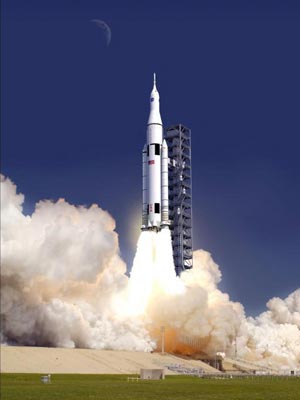
Rocket Launch
The NASA authorization bill that Congress passed nearly a year ago demanded not only that NASA build a new heavy-lift rocket, but also that the new system use space shuttle components. The new program, called the Space Launch System, didn’t disappoint in that regard. Its first stage and boosters will be similar to the shuttle propulsion system, at least initially, and it will use the new five-segment variants of the solid rocket boosters that were originally planned for the canceled Ares I and Ares V.
SLS will use a new expendable (and presumably cheaper) version of the liquid-oxygen/liquid-hydrogen Space Shuttle Main Engine (SSME), designated RS-25D/E. Its upper stage will also use oxygen and hydrogen—and include a throwback to the Apollo era: a modern version of the venerable J-2 upper-stage engine from the 1960s Saturn V, fittingly called J-2X. The diameter of the first and second stages will be the same as the shuttle external tank (about 27 feet), and probably built with the same tooling in Michoud, La. In its initial form, SLS will be able to deliver at least 70 metric tons to low-Earth orbit, as the legislation specifies, and could grow to 130 metric tons. That would make it the biggest rocket ever built, surpassing the Apollo Saturn V.
The Builders[]
Ostensibly, the reason for using this legacy hardware is to save money by minimizing new development. But recent analysis by Booz-Allen Hamilton indicates that it will actually cost much more than using new systems, partly because the SLS will employ expensive legacy workforces who worked on the shuttle. In fact, NASA administrator Charles Bolden laid out the real reason for the demand to use shuttle parts in his remarks today: “This launch system will create good-paying American jobs," he said, as well as "ensure continued U.S. leadership in space and inspire millions around the world.”
That is, the SLS plan wasn’t pushed through to save money so much as to save jobs in the states represented by the senators who wrote the legislation. But it’s good news for some other places, too, such as California. The Rocketdyne Division of Pratt & Whitney, which built both the SSME and the J-2X, had been facing a major decline in business with the retirement of the shuttle program. Jim Maser, the head of the division based in suburban L.A., tweeted last night: “In DC to talk future space policy with NASA/Congress. reps/DC press. Rumor is there might be an SLS announcement tomorrow . . . I’m optimistic.” If SLS continues, there will be a lot of development money for both engines. NASA may actually use leftover shuttle engines for the first flight or two if SLS gets off the ground. But after the leftovers are exhausted, each SLS flight would use up to five RS-25D/Es and one J-2X.
There may be more good news for California. Aerojet, a company in Sacramento that builds both solid and liquid engines (the only major company to do so), has demanded the right to compete for the solid rocket booster contract, and threatened to sue NASA if the agency gave the contact to SRB builder ATK without a bidding process.
The Future[]
So will the SLS program move forward smoothly now that NASA has settled on a design?
Don’t count on it. First, note what’s missing from the administrator’s praise of the program. Other than promising to “inspire” and “maintain leadership,” Bolden doesn’t offer any concrete plans for what the program will actually do. That’s because currently there are no actual missions planned or funded.
While NASA faces a congressional mandate to build a heavy-lift rocket, it also finds itself under harsh budget constraints. With the cost overruns on the James Webb Space Telescope (which Congress threatened to axe this summer) and the high cost of building the SLS, it’s hard to see where there will be any money to fund an actual mission.
If SpaceX delivers on its promise of a Falcon heavy rocket in the next couple of years at a price of $120 million a flight, and if NASA comes up with missions that don’t require a rocket as big and as expensive as the SLS, it will become increasingly difficult to justify spending tens of billions of dollars that we don’t have on a rocket that won’t fly for years, will fly only once or twice a year (or less) when it is finally ready, and that isn’t actually necessary to explore space. (Just yesterday, Rep. Dana Rohrabacher demanded that NASA release its assessment of an alternative plan to put a fuel depot in space to support commercial rockets.) Without a course correction, SLS could already be on the way to cancellation, like Constellation before it.
(Above information can from http://www.popularmechanics.com/science/space/nasa/nasas-space-launch-system-unveiled-analysis-6432937)